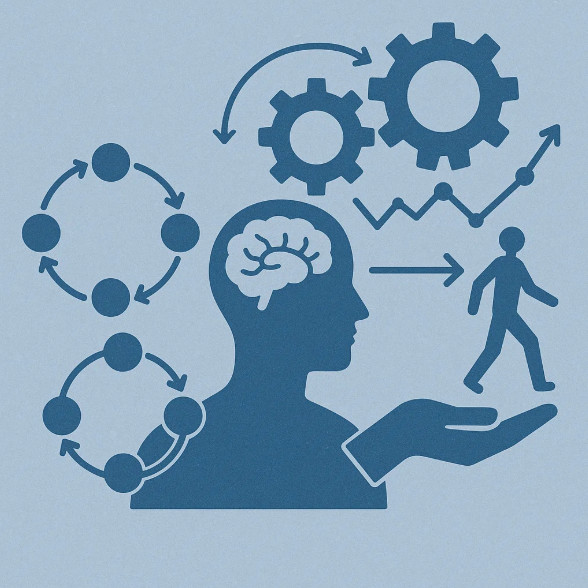Ψ∏ÌôîΕº Î∞îÍæ∏Îäî Í∏∞ÏàÝ
- 시스템으로 움직이는 조직, 말이 아닌 구조로 변화하다
Ï°∞ÏßÅÏùÄ Îßêΰú Î∞îÎÄåÏßÄ ÏïäÎäîÎã§. Ïä¨Î°úͱ¥, Ìè¨Ïä§ÌÑ∞, Ï∫ÝÌéòÏù∏, ΩîÏãúÏßÄ—Ïù¥ Ι®ÎìÝ Í≤ÉÏùÄ Î≥ÄÌôîÏùò Ψ¥ÎåÄÏû•ÏπòÏùº ÎøêÏù¥Îã§. ÏßÑÏßú Î≥ÄÌôîÎäî Î≥¥Ïù¥ÏßÄ ÏïäÎäî ÏãúÏä§ÌÖúÏóêÏÑú ÏãúÏûëÎêúÎã§. ÌöåÏùò ÏùºÏÝïÏù¥ Ïñ∏ÏÝú Ïû°ÌûàÎäîÍ∞Ä, Î≥¥ÏÉŠ͵¨Ï°∞Í∞Ä Î¨¥ÏóáÏùÑ Í∞ïÌôîÌïòÎäîÍ∞Ä, ÌîºÎìúÎ∞±Ïù¥ Ïñ¥ÎñªÍ≤å Ïù¥Î£®Ïñ¥ÏßÄÎäîÍ∞Ä. Í∑∏Í≤ÉÏù¥ Ψ∏ÌôîÏùò Ïñ∏Ïñ¥Ïù¥Ïûê Ï°∞ÏßÅÏùò Ïã§ÏÝú ÌñâÎèôÍ∑úÎ≤îÏù¥Îã§. Ϫ§ÎƧÎãàϺÄÏù¥ÏÖòÏùÄ ÌëúΩ¥Ïù¥Í≥Ý, ÏãúÏä§ÌÖúÏùÄ ÎºàÎåÄÎã§. ÏßÄÍ∏à Í∏∞ÏóÖÎì§ÏùÄ ‚ÄúÏ¢ãÏùÄ Îßê‚Äù ÎåÄÏãÝ ‚ÄúÎã§Î•¥Í≤å ÏûëÎèôÌïòÎäî ͵¨Ï°∞‚ÄùΕº ÎßåÎì§Í∏∞ ÏãúÏûëÌñàÎã§.
ÎßêÏùò ÏãúÎåÄÍ∞Ä ÎÅùÎÇòÍ≥Ý, ÏãúÏä§ÌÖúÏùò ÏãúÎåÄÍ∞Ä Ïò®Îã§
2020ÎÖÑÎåÄ Ï¥àÎ∞ò, ÏàòÎßéÏùÄ Í∏∞ÏóÖÏù¥ ‚ÄòÏ°∞ÏߊΨ∏Ìôî ÌòÅÏãÝ‚ÄôÏùÑ Ïô∏Ï≥§Îã§. Í∑∏Îü¨ÎÇò Í≤∞Í≥ºÎäî Ïã§ÎßùÏä§Îü¨ÏõÝÎã§. ÌïòÎ≤ÑÎìúÎπÑ϶àÎãàÏä§Î¶¨Î∑∞(HBR)Í∞Ä 2025ÎÖÑ Î∞úÌëúÌïú Ïó∞͵¨Ïóê Îî∞Ε¥Î©¥, Ψ∏ÌôîÎ≥ÄÌôî ÌîÑΰúÍ∑∏Îû®ÏùÑ Ïã§ÌñâÌïú Í∏∞ÏóÖÏùò 72%Í∞Ä 'ÏùòÎØ∏ ÏûàÎäî ÌñâÎèô Î≥ÄÌôî'Εº Î≥¥ÏßÄ Î™ªÌñàÎã§. Í∑∏ Ïù¥ÏúÝÎäî Îã®ÏàúÌñàÎã§. ÎåÄÎ∂ÄÎ∂ÑÏùò Ï°∞ÏßÅÏù¥ Ϫ§ÎƧÎãàϺÄÏù¥ÏÖò—϶â, ‚ÄúÏö∞ζ¨Ïùò Ψ∏ÌôîÎäî Í≥ÝÍ∞ù ϧëÏã¨ÏûÖÎãàÎ㧂Äù, ‚ÄúÌòëÎÝ•Í≥º ÏÜåÌܵÏùÑ Ï§ëÏãúÌï©ÎãàÎ㧂Äù Í∞ôÏùÄ Î¨∏͵¨—ÏóêÎßå ÏßëϧëÌñàÍ∏∞ ÎïåΨ∏Ïù¥Îã§. ΩîÏãúÏßÄÎäî ÎÑòÏ≥§ÏßÄÎßå, ÏãúÏä§ÌÖúÏùÄ Í∑∏ÎåÄΰúÏòÄÎã§.
Ψ∏ÌôîÎäî ΩîÏãúÏßÄÍ∞Ä ÏïÑÎãàÎùº ΩîϪ§Îãà϶òÏù¥Îã§. ÏòàΕº Îì§Ïñ¥, ÌöåÏùò ÏãúÍ∞ÑÏù¥ Ïñ∏ÏÝúÏù∏ÏßÄ, ÎàÑÍ∞Ä Î∞úÏñ∏Í∂åÏùÑ Í∞ñÎäîÏßÄ, ÏѱÍ≥ºÌèâÍ∞ÄÍ∞Ä Ïñ¥Îñ§ ÌñâÎèôÏùÑ Î≥¥ÏÉÅÌïòÎäîÏßÄ—Ïù¥ Ι®ÎìÝ Íµ¨Ï°∞Í∞Ä Ï°∞ÏßÅÏùò Ïã§ÏÝú Í∞ÄÏπòÍ¥ÄÏùÑ Í≤∞ÏÝïÌïúÎã§. ‚ÄúÏö∞ζ¨Îäî Ï∞ΩÏùòÏѱÏùÑ Ï§ëÏãúÌïúÎ㧂ÄùÍ≥Ý ÎßêÌïòΩ¥ÏÑú ÏÝïÌï¥ÏßÑ ÏÝàÏ∞®ÏôÄ ÏÑúÏó¥ÏùÑ Î∞îÍæ∏ÏßÄ ÏïäÎäîÎã§Î©¥, Ï∞ΩÏùòÏѱÏùÄ Í≤∞ÏΩî Î∞úÌòÑÎêòÏßÄ ÏïäÎäîÎã§. Ψ∏ÌôîÎûÄ Í≤∞͵≠ 'Ï°∞ÏßÅÏù¥ Ïñ¥ÎñªÍ≤å Í≤∞ÏÝïÏùÑ Îǥζ¨ÎäîÍ∞ÄÏùò Ìå®ÌÑ¥'Ïù¥Îã§.
구조로 말하는 조직: 보이지 않는 설계 언어
Ï°∞ÏßÅΨ∏ÌôîÎäî ÎààÏóê Î≥¥Ïù¥ÏßÄ ÏïäÎäî ÏѧÍ≥Ñ Ïñ∏Ïñ¥(Design Language)Îã§. ͵¨Í∏ÄÏùÄ 2010ÎÖÑÎåÄÎ∂ÄÌÑ∞ ‚ÄòÏã¨Î¶¨ÏÝÅ ÏïàÏÝÑÏѱ(psychological safety)‚ÄôÏùÑ Í∞ïÏ°∞ÌñàÏßÄÎßå, ÏßÑÏßú Î≥ÄÌôîÎäî ͵¨Ìò∏Í∞Ä ÏïÑÎãàÎùº ÏãúÏä§ÌÖúÏóêÏÑú ÏùºÏñ¥ÎǨÎã§. Í∑∏Îì§ÏùÄ ÌöåÏùòÏóêÏÑú Î∞úÏñ∏ ÏàúÏÑúΕº Ψ¥ÏûëÏúÑΰú ÏÝïÌïòÍ≥Ý, Îߧϣº ζ¨ÎçîÏóêÍ≤å ‚ÄúÏù¥Î≤à Ï£ºÏóê ÌåÄÏõêÏù¥ ÎãπÏãÝÏóêÍ≤å Ïù¥Í≤¨ÏùÑ ÏÝúÏãúÌñàÎäîÍ∞Ä?‚ÄùΕº ΨªÎäî ÌèâÍ∞Ä Ìï≠Ι©ÏùÑ ÎÑ£ÏóàÎã§. Í∑∏ Í≤∞Í≥º, ‚ÄúÏïàÏÝÑÌïú ÌôòÍ≤Ω‚ÄùÏù¥ÎùºÎäî Ï∂îÏÉÅÏÝÅ Í∞úÎÖêÏù¥ ͵¨Ï≤¥ÏÝÅÏù∏ ÌñâÎèô Ìå®ÌÑ¥ÏúºÎ°ú ÏÝÑÌôòÎêêÎã§.
ÎÑ∑Ìîåζ≠Ïä§ Ïó≠Ïãú ‚ÄúÏûêÏú®Í≥º ϱÖÏûÑ‚ÄùÏùÑ Îã®ÏßÄ Ïä¨Î°úͱ¥ÏúºÎ°ú Ïì∞ÏßÄ ÏïäÏïòÎã§. Î≥µÏû°Ìïú Í≤∞Ïû¨ÎùºÏù∏ÏùÑ ÏÝúͱ∞ÌïòÍ≥Ý, Ïó¨Ìñâ¬∑ÎπÑÏö©¬∑ÌîÑΰúÏÝùÌä∏ ÏäπÏù∏ Îì± Í±∞Ïùò Ι®ÎìÝ ÏùòÏǨÍ≤∞ÏÝï Í∂åÌïúÏùÑ ÌòÑÏû•Ïóê ÏúÑÏûÑÌñàÎã§. ÏÝúÎèÑÎäî Í≥ß ÏãÝ΢∞Ïùò Ïñ∏Ïñ¥ÏòÄÎã§. ÏãúÏä§ÌÖúÏù¥ Î∞îÎÄåÎãà Ϫ§ÎƧÎãàϺÄÏù¥ÏÖòÏùÄ ÏûêÏó∞Ìûà Îî∞ÎùºÏôîÎã§.
Î∞òΩ¥ ÏùºÎ∂Ä Ï°∞ÏßÅÏùÄ Î∞òÎåÄÏùò Í∏∏ÏùÑ Í±∏ÏóàÎã§. ÏǨÎÇ¥ Ïù¥Î©îÏùº, Ïä¨Îûô(Slack) Ï∫ÝÌéòÏù∏, ζ¨ÎçîÏã≠ Ïä§ÌîºÏπòΰú ‚ÄòÏó¥Î¶∞ Ψ∏Ìôî‚ÄôΕº Í∞ïÏ°∞ÌñàÏßÄÎßå, ÌèâÍ∞Ä Í∏∞ϧÄÏù¥ Ïó¨ÏÝÑÌûà ÏÉÅΙÖÌïòÎ≥µ ͵¨Ï°∞Ïóê Ψ∂Ïó¨ ÏûàÏóàÎã§. ÏßÅÏõêÎì§ÏùÄ ÎßêÌñàÎã§. ‚ÄúÎßêÏùÄ ÏûêÏúÝΰ≠ÏßÄÎßå, ͵¨Ï°∞Îäî ÏñµÏïïÏÝÅÏù¥Îã§.‚Äù ÏãúÏä§ÌÖúÏù¥ Î≥ÄÌïòÏßÄ ÏïäÏúºÎ©¥, ÎßêÏùÄ Í≥µÌóàÌï¥ÏßÑÎã§.
시스템은 ‘보이지 않는 행동 교사’다
Ï°∞ÏßÅÏóêÏÑú ÏãúÏä§ÌÖúÏùÄ ÏùºÏ¢ÖÏùò 'Ïà®ÏùÄ ÌñâÎèô ͵êÏǨ(hidden teacher)' Îã§. ͵¨ÏѱÏõêÏùÄ Í≥µÏãù ÏßÄÏπ®Î≥¥Î㧠Î≥¥ÏÉÅÍ≥º Ï≤òÎ≤åÏùò ͵¨Ï°∞ÏóêÏÑú ÌñâÎèô Í∑úÎ≤îÏùÑ ÌïôÏäµÌïúÎã§. ÏòàΕº Îì§Ïñ¥, Ìïú Í∏ÄΰúÎ≤å ÏÝúÏ°∞Í∏∞ÏóÖÏùÄ ‚ÄúÌòëÏóÖ Ï§ëÏ㨠Ψ∏Ìôî‚ÄùΕº ÏÑÝÏñ∏ÌñàÏßÄÎßå, Ïù∏ÏǨÌèâÍ∞Ä Ìï≠Ι©ÏóêÎäî Ïó¨ÏÝÑÌûà ‚ÄòÍ∞úÏù∏ÏѱÍ≥ºÏßÄÌëú‚ÄôÎßå Ï°¥Ïû¨ÌñàÎã§. ÌåÄÏõåÌŨΕº Ïù¥ÏïºÍ∏∞ÌïòΩ¥ÏÑúÎèÑ ÏѱÍ≥ºÍ∏âÏùÄ Í∞úÏù∏ Í≤ΩÏüÅÏóê Îî∞Îùº ÏßÄÍ∏âÎêòÏûê, ÌòëÏóÖÏùÄ ÏǨÎùºÏ°åÎã§. Í≤∞͵≠ Í∑∏ ÌöåÏǨÎäî ÌòëÎÝ• ÌîÑΰúÍ∑∏Îû® ÎåÄÏãÝ Í≤ΩÏüÅ Î≥¥Í≥ÝÏÑúΕº ÏñëÏÇ∞ÌñàÎã§.
Ïù¥Ïóê Î∞òÌï¥ Ìïú ÌïÄÌÖåÌŨ Í∏∞ÏóÖÏùÄ ÏãúÏä§ÌÖúÎ∂ÄÌÑ∞ Î∞îÍø®Îã§. Ι©ÌëúΕº Í∞úÏù∏ Îã®ÏúÑÍ∞Ä ÏïÑÎãàÎùº ÌåÄ Îã®ÏúÑΰú ÏѧÏÝïÌïòÍ≥Ý, ÏѱÍ≥ºÍ∏âÏùò 30%Εº ‚ÄòÍ≥µÎèôÍ∏∞Ïó¨ÎèÑ ÏßÄÏàò(collaboration index)‚Äôΰú Î∞∞Î∂ÑÌñàÎã§. Î∂àÍ≥º 6Í∞úÏõî ÎßåÏóê ÎÇ¥Î∂Ä ÎѧÌä∏ÏõåÌŨ ÌòëÏóÖΕÝÏù¥ 42% ÏÉÅÏäπÌñàÍ≥Ý, Î≥¥Í≥ÝÏÑúÎäî ÏÝàÎ∞òÏúºÎ°ú ϧÑÏóàÎã§. Ï°∞ÏßÅΨ∏ÌôîÎäî ÎßêÏù¥ ÏïÑÎãàÎùº 'Î≥¥ÏÉÅ ÏïåÍ≥Ýζ¨Ï¶ò'ÏóêÏÑú ÌÉúÏñ¥ÎÇúÎã§Îäî ÏǨÏã§ÏùÑ ÏûÖ϶ùÌïú ÏǨΰÄÎã§.
프로세스가 커뮤니케이션을 대체한다
Ï¢ãÏùÄ Ïª§ÎƧÎãàϺÄÏù¥ÏÖòÏùÄ ÏѧΙÖÏù¥ ÏïÑÎãàÎùº 'ÏòàÏ∏° Í∞ÄÎä•Ìïú ÌîÑΰúÏÑ∏Ïä§'Îã§. ÏùºÏÝïÏù¥ ΙÖÌôïÌïòÍ≥Ý, ÏùòÏǨÍ≤∞ÏÝï Í≤ΩΰúÍ∞Ä ÏùºÍ¥ÄÎêòΩ∞, ÏÝïÎ≥¥Í∞Ä Í≥µÍ∞úÏÝÅÏúºÎ°ú ÌùêΕº Îïå Ï°∞ÏßÅÏùò ÏãÝ΢∞ÏßÄÏàòÎäî Í∏âÍ≤©Ìûà ÎÜíÏïÑÏßÑÎã§. ÏǨÎûåÏùÄ ÎßêÎ≥¥Î㧠ÌñâÎèôÏóêÏÑú ÏùºÍ¥ÄÏѱÏùÑ ÏùΩÎäîÎã§. Ïù¥Îïå ÌîÑΰúÏÑ∏Ïä§Îäî ‚ÄúÏö∞ζ¨Îäî ÏÑúΰúΕº Ï°¥Ï§ëÌïúÎ㧂ÄùÎäî Ψ∏Ïû•Î≥¥Î㧠Ìõ®Ïî¨ Í∞ïÎÝ•Ìïú ÏãÝÌò∏Í∞Ä ÎêúÎã§.
ÏòàΕº Îì§Ïñ¥, ÌöåÏùòÏóêÏÑú ÏÉÅÏǨÍ∞Ä Î®ºÏÝÄ Î∞úÏñ∏ÌïòÎäî ͵¨Ï°∞Îäî ÏàòÌèâÏÝÅ ÌÜÝΰÝÏùÑ Î∂àÍ∞ÄÎä•ÌïòÍ≤å ÎßåÎìÝÎã§. Î∞òÎåÄΰú, ÏïÑÎßàÏ°¥Ïùò ‚ÄòÏǨÏùºÎü∞Ìä∏ ÎØ∏ÌåÖ(silent meeting)‚Äô Î∞©ÏãùÏùÄ Íµ¨Ï°∞ ÏûêÏ≤¥Í∞Ä Î©îÏãúÏßÄΕº Î∞îÍæºÎã§. Ι®ÎëêÍ∞Ä ÌöåÏùò Ï¥àÎ∞ò 15Î∂ÑÍ∞Ñ ÏûêΣåΕº ÏùΩÏúºÎ©∞ ÏùòÍ≤¨ÏùÑ ÏÝïζ¨Ìïú Îí§ ÌÜÝΰÝÏùÑ ÏãúÏûëÌïúÎã§. Ïù¥Îäî ‚ÄúΙ®ÎìÝ ÏǨÎûåÏù¥ ÎèôÏùºÌïú ÏÝïÎ≥¥ Í∏∞Î∞ò ÏúÑÏóêÏÑú ÎßêÌïÝ Ïàò ÏûàÎ㧂ÄùÎäî ÏãúÏä§ÌÖúÏÝÅ ÏÑÝÏñ∏Ïù¥Îã§.
϶â, Ψ∏ÌôîÎäî ÏãúÏä§ÌÖú ÏÜçÏóê Ïà®Ïñ¥ ÏûàÎäî ΩîÏãúÏßÄÎã§. Ïûò ÏѧÍ≥ÑÎêú ÏãúÏä§ÌÖúÏùÄ ÎßêÏùÑ ÌïòÏßÄ ÏïäÏïÑÎèÑ ÏùòÎèÑΕº ÏÝÑÎã¨ÌïúÎã§.
Î≥ÄÌôîÎäî ÎîîÏûêÏù∏Ïùò Ψ∏ÏÝúÍ∞Ä ÎêúÎã§
Ψ∏Ìôî Î≥ÄÌôîÎäî Í≤∞͵≠ 'ÎîîÏûêÏù∏Ïùò Ψ∏ÏÝú'Îã§. Ïñ∏Ïñ¥Î•º ÏѧÍ≥ÑÌïòÎìØ, Ï°∞ÏßÅÏùò ͵¨Ï°∞Εº ÎîîÏûêÏù∏Ìï¥Ïïº ÌïúÎã§. ÌïòÎ≤ÑÎìú Í≤ΩÏòÅÎåÄÌïôÏùò Ïó∞͵¨Îäî Ïù¥Î•º ‚ÄúStructural Storytelling‚ÄùÏù¥Îùº Î∂ÄΕ∏Îã§. Ïù¥Îäî ‚ÄòÏù¥ÏïºÍ∏∞Εº ͵¨Ï°∞ΰú ͵¨ÌòÑÌïúÎ㧂ÄôÎäî Í∞úÎÖêÏù¥Îã§. ÏòàΕº Îì§Ïñ¥, ‚ÄòÍ≥ÝÍ∞ù ϧëÏ㨠Ψ∏Ìôî‚ÄôΕº ÎßåÎì§Í≥Ý Ïã∂Îã§Î©¥, ÌöåÏùò ÏïÑÏÝÝÎ㧠Ï≤´ Ìï≠Ι©ÏùÑ ‚ÄòÍ≥ÝÍ∞ù ÌîºÎìúÎ∞± ÏöîÏïΩ‚ÄôÏúºÎ°ú Í≥ÝÏÝïÌïúÎã§. ‚ÄòÏã§Ìå®Î•º ÎëêÎݧÏõåÌïòÏßÄ ÏïäÎäî Ψ∏Ìôî‚ÄôΕº ÏõêÌïúÎã§Î©¥, ÏǨÎÇ¥ Ìè¨ÌÑ∏Ïóê ‚ÄúÏù¥Î≤à Ï£ºÏùò Ïã§Ìå® Ïã§Ìóò‚Äù ÏΩîÎÑàΕº ÎßåÎìÝÎã§.
Ïù¥Í≤ÉÏù¥ ÏãúÏä§ÌÖúÏúºÎ°ú ÎßêÌïòÎäî Î≤ïÏù¥Îã§. ζ¨ÎçîÏùò Ïñ∏Ïñ¥Î≥¥Î㧠ÏùºÏÝïÌëú¬∑Í≤∞Ïû¨¬∑ÌîÑΰúÏÑ∏Ïä§Í∞Ä Îçî ÌÅ∞ ÏѧÎìùÎÝ•ÏùÑ Í∞ÄÏßÄÎäî Ïù¥ÏúÝÎã§. Ψ∏ÌôîÎäî Í≤∞͵≠ ÎߧÏùº Î∞òÎ≥µÎêòÎäî ÌñâÎèôÏùò Ï¥ùÌï©Ïù¥Îã§. Îî∞ÎùºÏÑú Î≥ÄÌôîÏùò ÏãúÏûëÏÝêÏùÄ ÏÉàΰúÏö¥ Îã®Ïñ¥Í∞Ä ÏïÑÎãàÎùº 'ÏÉàΰúÏö¥ Σ®Ìã¥'Ïù¥Îã§. Î≥ÄÌôîÎäî ΩîÏãúÏßÄÍ∞Ä ÏïÑÎãàÎùº ÏãúÍ∞ÑÌëú ÏúÑÏóêÏÑú Î∞úÏÉùÌïúÎã§.
Í∏∞ÏàÝÏ≤òÎüº ÏûëÎèôÌïòÎäî Ψ∏Ìôî
Ïò§ÎäòÎÇÝ Ï°∞ÏßÅÏùÄ ÌïòÎÇòÏùò Í∏∞ÏàÝ ÏãúÏä§ÌÖúÏóê Í∞ÄÍπùÎã§. HR, IT, Ïû¨Î¨¥, Îç∞Ïù¥ÌÑ∞, ÌòëÏóÖ ÌîåÎû´Ì躗all integrated. Îî∞ÎùºÏÑú Ψ∏Ìôî Ïó≠Ïãú Í∏∞ÏàÝÏ≤òÎüº ÏѧÍ≥ÑÎêòÍ≥Ý, ÏóÖÎç∞Ïù¥Ìä∏ÎêòÍ≥Ý, ÌîºÎìúÎ∞±ÎêòÏñ¥Ïïº ÌïúÎã§. ÎßàÏù¥ÌŨΰúÏÜåÌîÑÌä∏Îäî 2024ÎÖÑ Ïù¥ÌõÑ AI Í∏∞Î∞ò Ïù∏ÏǨÎ∂ÑÏÑù ÏãúÏä§ÌÖúÏùÑ ÎèÑÏûÖÌñàÎã§. Ïù¥Î©îÏùº¬∑ÌöåÏùò¬∑ÏûëÏóÖ Ìå®ÌÑ¥ÏùÑ Î∂ÑÏÑùÌï¥, ÌòëÏóÖÏùò Î≥ëΙ©Í≥º ζ¨ÎçîÏã≠ Í≥ºÎ∂ÄÌïòΕº ÏãúÍ∞ÅÌôîÌïúÎã§. Ïó¨Í∏∞ÏÑú Ï£ºÎ™©ÌïÝ ÏÝêÏùÄ Îç∞Ïù¥ÌÑ∞Εº ÌܵÌï¥ ‚ÄòÎàÑÍ∞Ä ÎßêÏùÑ ÎßéÏù¥ ÌïòÎäêÎÉê‚ÄôÍ∞Ä ÏïÑÎãàÎùº ‚ÄòÏñ¥Îñ§ ÏãúÏä§ÌÖúÏù¥ ÌîºÎ°úΕº ÏúÝÎ∞úÌïòÎäêÎÉê‚ÄôΕº Ï∏°ÏÝïÌïúÎã§Îäî Í≤ÉÏù¥Îã§. Í≤∞Í≥ºÏÝÅÏúºÎ°ú Ï°∞ÏßÅΨ∏ÌôîÎäî Í∞êÏÝïÏù¥ ÏïÑÎãàÎùº 'Îç∞Ïù¥ÌÑ∞ΰú Í¥Äζ¨ÎêòÎäî ÌñâÎèô ÏÉùÌÉúÍ≥Ñ'ΰú ÏÝÑÌôòÎêòÍ≥Ý ÏûàÎã§.
Ïù¥Îäî ÎÉâÏÝïÌïú Í∏∞ÏàÝÏ£ºÏùòÍ∞Ä ÏïÑÎãàÎã§. Ïò§ÌûàÎݧ Ψ∏ÌôîÏôÄ Ïù∏Í∞Ñ ÏǨÏù¥Ïùò ÏÉàΰúÏö¥ Í∑ÝÌòïÏÝêÏù¥Îã§. Ï°∞ÏßÅÏùò Ïã¨Ïû•ÏùÄ Ïó¨ÏÝÑÌûà ÏǨÎûåÏóê ÏûàÏßÄÎßå, Í∑∏ Î∞ïÎèôÏùÑ Ï°∞ÏÝàÌïòÎäî Í≤ÉÏùÄ ÏãúÏä§ÌÖúÏù¥Îã§.
말이 아닌 구조로 말하는 시대
ÌöåÏǨÎäî ÎߧÏùº Í∞ôÏùÄ ÎßêÏùÑ ÎêòÌíÄÏù¥ÌïúÎã§. ‚ÄúÏö∞ζ¨Îäî ÌòÅÏãÝÏÝÅÏù¥Îã§.‚Äù ‚ÄúÏö∞ζ¨Îäî ÏàòÌèâÏÝÅÏù¥Îã§.‚Äù ÌïòÏßÄÎßå ÏßÑÏÝïÌïú Î≥ÄÌôîÎäî ÌëúÏñ¥Í∞Ä ÏïÑÎãàÎùº ÏѧÍ≥ÑÏóê ÏûàÎã§. ÏãúÏä§ÌÖúÏù¥ ÌòÅÏãÝÏÝÅÏù¥ÏßÄ ÏïäÎã§Î©¥ ÌòÅÏãÝÏùÄ Ï°¥Ïû¨ÌïòÏßÄ ÏïäÎäîÎã§. ͵¨Ï°∞Í∞Ä ÏàòÌèâÏÝÅÏù¥ÏßÄ ÏïäÎã§Î©¥ ÌèâÎì±ÏùÄ ÌóàÏÉÅÏù¥Îã§.
Ï°∞ÏßÅÏùÄ Ïñ∏Ïñ¥Î°ú ÏûêÏãÝÏùÑ ÏѧΙÖÌïòÏßÄÎßå, ÏãúÏä§ÌÖúÏúºÎ°ú ÏûêÏãÝÏùÑ Ï¶ùΙÖÌïúÎã§. ÏïûÏúºÎ°úÏùò Í∏∞ÏóÖÏùÄ Î¨∏Ìôî Îã¥Îãπ Î∂ÄÏÑúΕº Ïö¥ÏòÅÌïòÍ∏∞Î≥¥Îã§, 'Ψ∏Ìôî ÏóîÏßÄÎãàÏñ¥'Εº ÌïÑÏöîΰú ÌïÝ Í≤ÉÏù¥Îã§. Í∑∏Îì§ÏùÄ Î¨∏Ïû•ÏùÑ Ïì∞ÏßÄ ÏïäÍ≥Ý, ͵¨Ï°∞Εº ÏѧÍ≥ÑÌïúÎã§. Í∑∏Îì§ÏùÄ Î©îÏãúÏßÄΕº ÏÝÑÌïòÏßÄ ÏïäÍ≥Ý, ÌñâÎèôÏùÑ ÏúÝÎèÑÌïúÎã§.
Ψ∏ÌôîÎäî Ïù¥ÏÝú Í∏∞ÏàÝÏùò Ïñ∏Ïñ¥Î°ú Î≤àÏó≠ÎêòÏñ¥Ïïº ÌïúÎã§. Ïö∞ζ¨Í∞Ä ÏãúÏä§ÌÖúÏùÑ Î∞îÍæ∏Ω¥, Í∑∏ ÏãúÏä§ÌÖúÏù¥ ÏǨÎûåÏùÑ Î∞îÍæºÎã§. ÎßêÏù¥ ÏïÑÎãàÎùº ÏѧÍ≥Ñΰú, ͵¨Ìò∏Í∞Ä ÏïÑÎãàÎùº ÏïåÍ≥Ýζ¨Ï¶òÏúºÎ°ú. Í∑∏Í≤ÉÏù¥ Ï°∞ÏßÅÏù¥ Ïä§Ïä§Î°ú ÏßÑÌôîÌïòÎäî ÏúÝÏùºÌïú Î∞©Î≤ïÏù¥Îã§.
Reference
Harvard Business Review (2025). ‚ÄúTo Change Company Culture, Focus on Systems — Not Communication.‚Äù August 2025 Issue.
The Technology of Culture
- Organizations that Move through Systems, Not Words
Organizations do not change through words. Slogans, posters, campaigns, messages—all of these are stage props for change. Real transformation begins in the invisible system. When are meetings scheduled? What behaviors does the reward structure reinforce? How is feedback delivered? These are the true language of culture and the behavioral code of an organization. Communication is the surface; systems are the skeleton. Today‚Äôs companies are no longer trying to craft ‚Äúbetter messages‚Äù—they are building structures that behave differently.
The Age of Words Ends, and the Age of Systems Begins
In the early 2020s, countless companies proclaimed ‚Äúcultural innovation.‚Äù The results were disappointing. According to a 2025 Harvard Business Review study, 72 percent of companies that launched culture-change programs 'saw no meaningful behavioral change'. The reason was simple. Most organizations focused solely on communication—statements like ‚ÄúOur culture is customer-centric,‚Äù or ‚ÄúWe value collaboration and openness.‚Äù The message was abundant, but the system remained untouched.
Culture is not a message; it is a mechanism.
Consider how meetings are run, who holds the right to speak, and what behaviors are rewarded in performance evaluations—these structural choices define an organization‚Äôs real values. When a company claims to ‚Äúvalue creativity‚Äù but never changes its hierarchy or procedures, creativity will never flourish. Culture, at its core, is the 'pattern by which decisions are made'.
Speaking through Structure: The Invisible Design Language
Organizational culture is an invisible 'design language'. Google, for instance, emphasized “psychological safety” for years, but the real change came not from slogans, but from systems. The company randomized speaking order in meetings and added a new evaluation question for managers: “Did a team member disagree with you this week?” The abstract idea of “safety” thus became a tangible behavior pattern.
Netflix also avoided reducing “freedom and responsibility” to a tagline. It removed layers of approval and delegated authority for travel, budgeting, and project decisions directly to teams. The policy itself was a language of trust. When the system changed, communication followed naturally.
Others took the opposite path. They launched internal email campaigns, Slack slogans, and executive speeches promoting an “open culture,” while maintaining the same top-down evaluation system. Employees quickly noticed: “The words are free, but the structure is oppressive.” If the system does not change, the message becomes hollow.
Systems Are the Hidden Teachers of Behavior
Within organizations, systems act as 'hidden teachers'. Employees learn behavioral norms not from official guidelines, but from the architecture of reward and punishment.
For example, one global manufacturing firm declared a ‚Äúcollaborative culture,‚Äù yet its HR evaluation still relied entirely on individual performance indicators. Although management preached teamwork, bonuses were tied to personal competition—so collaboration vanished. The company ended up producing more competitive reports than cooperative outcomes.
By contrast, a fintech company approached the issue structurally. It set goals at the team level, not the individual level, and allocated 30 percent of bonuses based on a 'collaboration index'. Within six months, internal cross-department collaboration rose 42 percent, while the volume of redundant reports fell by half. The case proved that organizational culture is born not from words but from the 'algorithm of rewards'.
Process Replaces Communication
Effective communication is not explanation but 'predictable process'. When schedules are transparent, decision paths consistent, and information flows openly, organizational trust rises sharply. People read consistency in action, not in words. A clear process sends a stronger message than any corporate statement.
Take meetings where the boss always speaks first—true open discussion becomes impossible. By contrast, Amazon‚Äôs ‚Äúsilent meeting‚Äù format flips the dynamic. Participants spend the first 15 minutes quietly reading materials before discussion begins. This is not just a ritual—it is a systemic declaration: 'everyone deserves the same informational footing before they speak.' Culture, then, is the message hidden inside the system. A well-designed process communicates intention without uttering a word.
Change Becomes a Question of Design
Ultimately, cultural change is a 'design problem'. Just as we design language, we must design structure. Researchers at Harvard Business School call this ‚Äústructural storytelling‚Äù—the act of turning a story into a system.
If a company seeks a “customer-centric culture,” the first item on every meeting agenda should be “Customer feedback summary.” If it wants a “fearless innovation culture,” the internal portal should include a section titled “This Week’s Failed Experiments.”
That is how an organization speaks through its systems. Schedules, approval paths, and workflows are far more persuasive than leadership speeches.
Culture is the sum of daily routines. The starting point of change, therefore, is not new vocabulary but 'new routines'. Transformation does not occur in a message; it occurs on the calendar.
Culture That Operates Like Technology
Modern organizations increasingly resemble technology systems—HR, IT, finance, data, and collaboration platforms are all interconnected. Consequently, culture too must be designed, updated, and iterated like technology.
Since 2024, Microsoft has implemented an AI-based people-analytics system that visualizes collaboration bottlenecks and leadership overload by analyzing emails, meetings, and workflow patterns. Crucially, the data measures not “who talks most,” but 'which systems cause fatigue'. As a result, organizational culture is shifting from an emotional ideal into a 'data-driven behavioral ecosystem'.
This is not cold technocracy—it is a new equilibrium between people and systems. The heart of the organization remains human, but its rhythm is regulated by design.
Speaking through Structure, Not Speech
Every company repeats the same lines: “We are innovative.” “We are flat.” But real transformation is not in slogans; it is in design. If the system is not innovative, innovation does not exist. If the structure is not flat, equality is an illusion.
Organizations describe themselves through language but prove themselves through systems. The company of the future will not need a ‚ÄúCulture Department‚Äù so much as it will need 'culture engineers'—professionals who design frameworks instead of sentences, who shape behavior instead of broadcasting messages.
Culture must now be translated into the language of technology. When we change the system, the system changes the people. Not by words, but by design. Not by slogans, but by algorithms. That is the only way an organization can truly evolve on its own.
Reference
Harvard Business Review (2025). ‚ÄúTo Change Company Culture, Focus on Systems — Not Communication.‚Äù August 2025 Issue.







